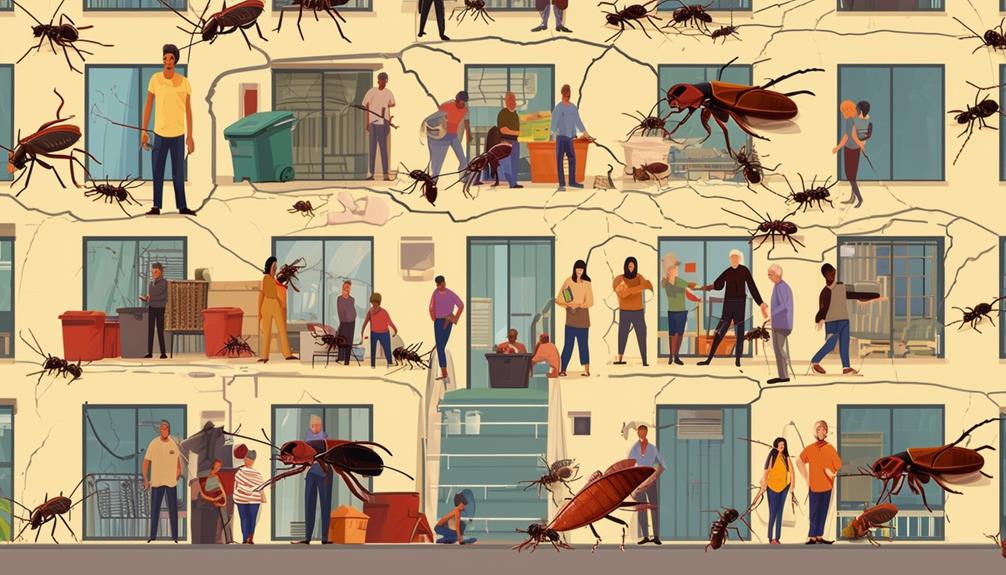Pest infestation, an unfortunate occurrence that can turn a comfortable home into a breeding ground for unwanted guests. While some may find the idea of sharing their living spaces with pests to be an intriguing adventure akin to a real-life Disney movie, most individuals would rather avoid such encounters altogether. Fortunately, there are ways to detect the signs of a pest infestation early on, allowing for prompt action to be taken.
In this article, we will explore the objective and scientific signs that indicate the presence of pests in a home, enabling readers to recognize and address these unwelcome intruders.
The first indication of a pest infestation is often the presence of droppings. These small, often inconspicuous, deposits can be found in various areas of the home, such as kitchen cabinets, pantries, or even between floorboards. While the sight of droppings may initially incite a sense of disgust, it serves as a valuable clue in identifying the type and extent of the infestation.
Additionally, chewed-up wires or furniture can also suggest the presence of pests. Their insatiable appetite for anything in their path can lead them to gnaw on electrical wires or wooden furniture, leaving behind telltale signs of their presence. By being vigilant and observant, individuals can catch these early signs and prevent potential damage or hazards caused by pests.
Key Takeaways
- Pest infestations can be identified by the presence of specific signs, such as clusters of spider webs and holes in the pantry.
- Pests are attracted to areas with food, water, and shelter, so keeping these areas clean and sealed off can help prevent infestations.
- Regularly inspecting and monitoring for visible signs of pest activity is crucial in detecting and addressing infestations early.
- Understanding pest habitats and their preferences can help homeowners take appropriate pest control measures and protect their homes from the risks associated with pests.
Presence of Droppings
The presence of droppings is indicative of a potential pest infestation and can serve as a reliable indicator for the need of further investigation and appropriate pest control measures.
Rodent droppings, for example, are a common sign of a rodent infestation. These droppings are typically small, cylindrical in shape, and may be scattered throughout the infested area. They can be found in areas where rodents are active, such as along walls, in corners, and near food sources. By identifying and monitoring the presence of rodent droppings, homeowners and pest control professionals can assess the severity of the infestation and take appropriate actions to eliminate the pests.
Another type of droppings that can indicate a pest infestation is termite frass. Termite frass refers to the excrement produced by termites as they feed on wood and other cellulose materials. Termite frass often resembles tiny pellets or sawdust and can be found near termite tunnels or in areas where termites are actively feeding. The presence of termite frass is a strong indication of a termite infestation and should be taken seriously. It is important to note that termite frass can easily be mistaken for sawdust or other debris, so it is crucial to consult with a professional to accurately identify the source of the droppings.
The presence of droppings, whether it be rodent droppings or termite frass, should not be ignored as they are clear signs of a potential pest infestation.
In addition to droppings, another common sign of a pest infestation is chewed-up wires or furniture. This will be discussed in the subsequent section.
Chewed-Up Wires or Furniture
Indicative of an infestation, wires or furniture that have been visibly chewed up serve as clear evidence of pest activity. The damage assessment of chewed wires or furniture can provide valuable insights into the type of pest responsible for the infestation.
For instance, rodents like rats or mice are notorious for gnawing on electrical wires, which can pose a significant fire hazard. Additionally, these pests may target wooden furniture, causing unsightly damage and compromising its structural integrity. By examining the extent and pattern of the damage, pest control professionals can determine the severity of the infestation and devise appropriate prevention methods.
To gain a deeper understanding of the implications of chewed-up wires or furniture, it is crucial to consider the sub-lists within the nested bullet point list.
Firstly, the extent of the damage can indicate the duration of the infestation. Severe damage suggests that the pests have been present for an extended period, while minor damage may indicate a recent invasion.
Secondly, the location of the damage can provide insights into the pests’ behavior and nesting habits. For example, gnawing on wires near food sources or nesting areas may suggest the presence of rodents. On the other hand, damage to furniture in secluded areas may indicate the presence of insects or other small pests.
By carefully analyzing these factors, pest control professionals can develop effective strategies to eliminate the infestation and prevent future occurrences.
Transitioning into the subsequent section about ‘strange noises in the walls,’ it is important to note that chewed-up wires or furniture are not the only signs of a pest infestation. In addition to visible damage, auditory cues such as strange noises in the walls can also indicate the presence of pests.
Strange Noises in the Walls
Strange noises emanating from within the walls can be an unsettling and nerve-wracking experience, hinting at the possible presence of elusive and mysterious creatures.
These noises can manifest as wall vibrations or scratching sounds, which often leave homeowners perplexed and concerned about potential pest infestations.
Wall vibrations are typically caused by larger pests, such as rats or squirrels, that are actively moving and scurrying within the walls. These creatures can create vibrations as they navigate through tight spaces, using their claws and bodies to propel themselves forward. The resulting vibrations can be felt and heard by those residing in the home, causing a sense of unease and distress.
Additionally, scratching sounds are another common indication of a pest infestation within the walls. These sounds often originate from smaller pests, such as mice or insects, as they gnaw on materials or scuttle along surfaces. The scratching noises can vary in intensity and frequency, depending on the size and activity level of the pests. Homeowners may hear these sounds predominantly during the night when pests are most active, adding a layer of anxiety to their overall experience.
As we transition to the subsequent section about ‘unusual odors,’ it is important to note that strange noises in the walls are not always definitive proof of a pest infestation. They can also be caused by other factors such as thermal expansion or contraction of building materials. Therefore, it is crucial to consider additional signs and evidence to accurately determine the presence of pests within the premises.
Unusual Odors
Unusual odors emanating from within a space can evoke a sense of discomfort and concern, prompting individuals to investigate potential sources and causes. In the context of pest infestation, peculiar smells can often be an indication of an underlying problem. Different pests leave behind distinct odors, which can aid in identifying the type of infestation and implementing the appropriate pest control methods. To better understand the relationship between odors and pests, it is helpful to consider a table that outlines some common pest infestations and their associated smells.
| Pest Infestation | Odor Description | Identifying Characteristics |
|---|---|---|
| Rodents | Musty or urine-like odor | Droppings, gnaw marks, scurrying noises |
| Cockroaches | Greasy or musty odor | Droppings, egg casings, nocturnal activity |
| Bed bugs | Sweet, musty, or offensive odor | Small blood stains on bedding, bite marks |
Identifying pest infestation early is crucial to prevent further damage and minimize the risk of health issues. By recognizing the specific odors associated with different pests, individuals can take prompt action and implement the appropriate pest control methods. Transitioning into the subsequent section about visible pest activity, it is important to note that while odors can provide valuable information, they should be considered alongside other signs, such as the presence of droppings, gnaw marks, or bite marks.
Visible Pest Activity
Evident in a space are visible traces of pest activity, presenting tangible evidence of their presence and the potential risks they pose.
One of the most common signs of pest infestation is the sight of actual pests themselves. Whether it’s ants marching in a straight line, cockroaches scurrying across the floor, or mice leaving droppings behind, these visible pests are a clear indication that an infestation is underway. By observing their behavior and movement patterns, pest control professionals can gather important information about the type and extent of the infestation, allowing them to devise effective pest control methods.
In addition to the pests themselves, their habitats can also serve as visible signs of infestation. Pests have specific preferences when it comes to their living conditions, and they tend to congregate in areas that provide them with food, water, and shelter.
This means that if you spot clusters of spider webs in the corners of your home or discover holes in your pantry where rodents have been feasting, it’s likely that you have a pest problem. Understanding common pest habitats can help in identifying infestations and implementing appropriate pest control measures.
By keeping an eye out for visible signs of pest activity and familiarizing oneself with their preferred habitats, individuals can take proactive steps to prevent infestations and protect their homes from the potential risks that pests pose.
Frequently Asked Questions
How can I prevent a pest infestation in my home?
To prevent a pest infestation in your home, employ natural pest control methods and identify and seal common entry points for pests. These measures can effectively deter pests without the use of harmful chemicals or pesticides.
Can pests cause health problems for humans?
Pests can transmit diseases to humans, posing serious health risks. Common diseases transmitted by pests include Lyme disease, West Nile virus, and Hantavirus. Living with pests can also lead to long-term health effects such as respiratory issues and allergies.
What are some common hiding places for pests in a house?
Pests often seek refuge in inconspicuous areas of a home. Common hiding places include kitchen cabinets and the undersides of sinks. Understanding these favored locations can aid in effective pest control measures.
Are there any natural remedies or deterrents for getting rid of pests?
Natural pest control methods and DIY pest repellents can be effective in getting rid of pests. Some options include using essential oils, vinegar, or diatomaceous earth. These remedies can help deter pests without the use of harmful chemicals.
How long does it usually take to get rid of a pest infestation once it has been identified?
The duration to eliminate a pest infestation varies depending on factors such as the type and extent of the infestation, the pest control professional’s expertise, and the chosen eradication methods. Costs associated with pest extermination depend on the severity of the infestation and the chosen professional. To choose a pest control professional, one should consider their experience, certifications, and customer reviews.





